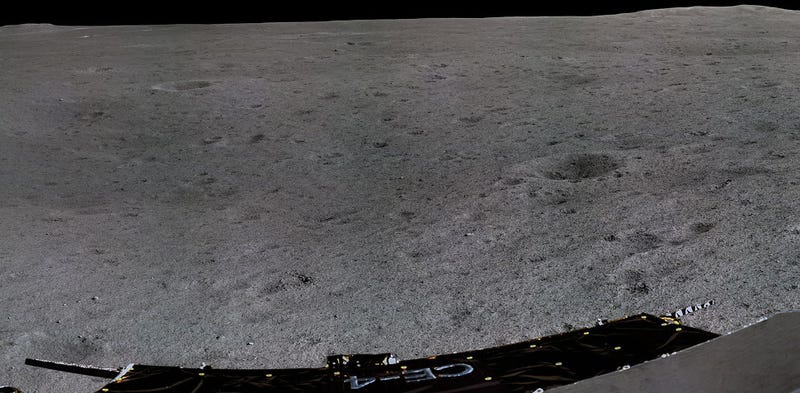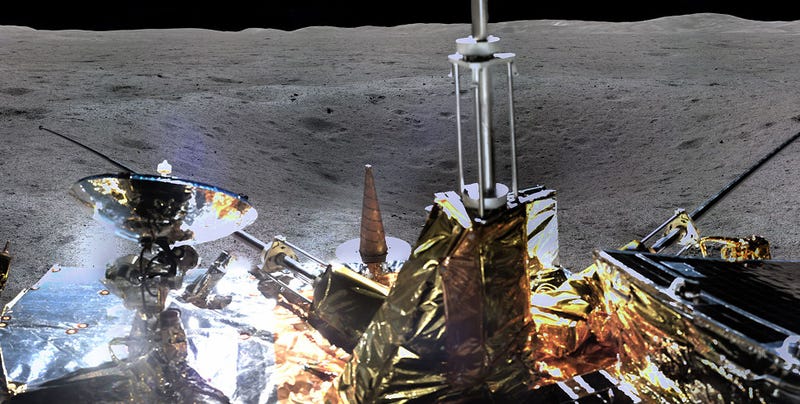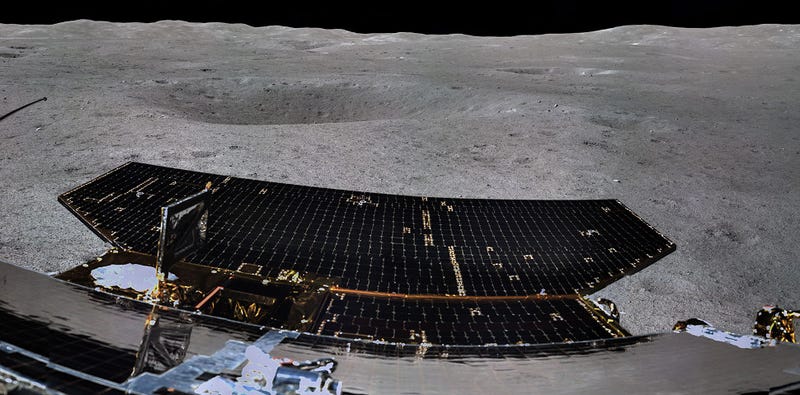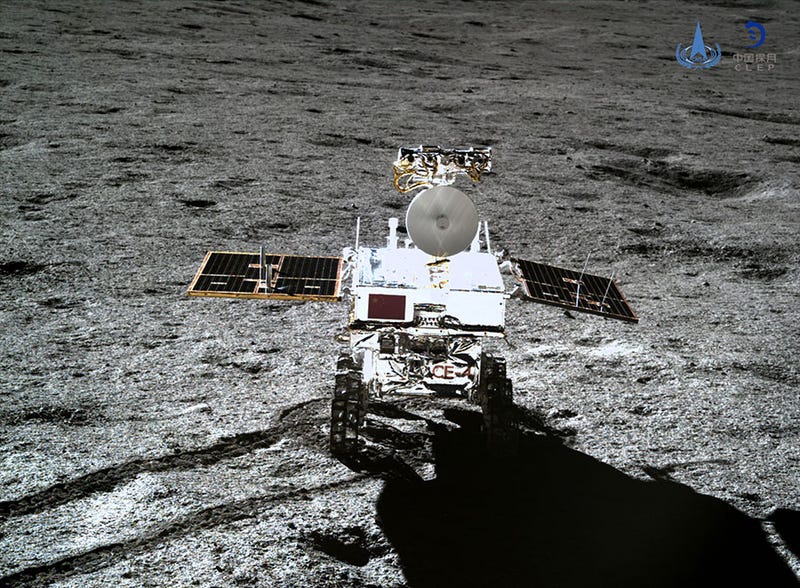See the First Panorama of the Far Side of the Moon, Captured by China’s Chang’e 4 Lander

The Moon’s far side near its southern pole is a dead, dim place littered with pits and rocks, as the first panoramic image taken by China’s Change’ 4 lander confirms.
Eight days after its historic landing on the far side of the Moon, China’s Chang’e 4 lander has captured its first panoramic image. The panorama, a mosaic consisting of 80 individual images, offers a 360-degree view of the lander’s immediate surroundings, showing the jagged horizon line, some small rocks, its partner—the Jade Rabbit 2 lunar rover—and a plethora of small craters.
 The entire 360-degree panorama, stitched together from 80 individual images. Image: CNSA
The entire 360-degree panorama, stitched together from 80 individual images. Image: CNSA
Indeed, the surprising number of craters around the landing site will pose “a great challenge” for the lunar rover during future explorations, noted the Xinhua news agency. Ironically enough, Chang’e 4 landed inside a crater—the Von Karman Carter within the South Pole-Aitken basin, one of the largest documented impact craters in the Solar System. The lander and rover are currently 20,000 feet (6,000 metres) below the Moon’s sea level, so to speak. Or if you like technical terms, below the common equipotential surface.
 A section of the new 360-degree panorama, revealing a bunch of craters. Image: CNSA
A section of the new 360-degree panorama, revealing a bunch of craters. Image: CNSA
“The information from the depths of the Moon will be one of our focuses in the exploration,” Li Chunlai, deputy director of the National Astronomical Observatories of China, told Xinhua, adding that, “From the panorama, we can see the probe is surrounded by lots of small craters, which was really thrilling.”
 A section of the new 360-degree panorama, showing instruments on Chang’e 4 and a sizable pit on the lunar surface. Image: CNSA
A section of the new 360-degree panorama, showing instruments on Chang’e 4 and a sizable pit on the lunar surface. Image: CNSA
One of the craters close to the lander measures around 65 feet wide (20 metres) and 13 feet deep (4 metres). Mission planners at the China National Space Administration (CNSA) will have to be wary this and other pits as they control the movements of Jade Rabbit 2, also known as Yutu 2.
 A section of the new 360-degree panorama, and yet another big crater nearby. Image: CNSA
A section of the new 360-degree panorama, and yet another big crater nearby. Image: CNSA
Images from the surface are being transmitted to a Chinese lunar relay satellite, called Queqiao (meaning Magpie Bridge), which in turn bounced the data back to Earth. In addition to confirming the reliability of this relay link, CNSA mission controllers have managed to boot up Chang’e 4's instruments and performed “two-way mutual shooting,” in which the lander and probe took photos of each other.
 The Chang’e 4 lander, as photographed by the Jade Rabbit 2 lunar rover. Image: CNSA
The Chang’e 4 lander, as photographed by the Jade Rabbit 2 lunar rover. Image: CNSA
“The image clearly shows the landform of the [moonscape] around the lander and the rover, and the five-star red flag on the two devices is particularly eye-catching,” noted the CNSA in a release.
 The Jade Rabbit 2 lunar rover, as photographed by the Chang’e 4 lander. Image: CNSA
The Jade Rabbit 2 lunar rover, as photographed by the Chang’e 4 lander. Image: CNSA
Very importantly, Chang’e 4 and Jade Rabbit 2 survived a lunar night, during which the devices were placed in hibernation mode. Back in 2016, the forbearer of Jade Rabbit 2 could not handle the frigid temperatures, expiring shortly after landing. The CNSA release described this preliminary stage of the mission as a “complete success,” saying the mission can now proceed to the scientific exploration stage.
In addition to the new panorama, the CNSA released a video of the Chang’e 4 landing—a video consisting of over 4,700 images captured by the lander’s camera, Xinhua reported. Analysis of the video shows that the the lunar dust is quite thick at the landing site, suggesting the “lunar regolith in the region has undergone longer space weathering, which also gives strong evidence of the region being older,” Li told Xinhua.
Together, the lander and rover will collect scientific data about the lunar environment, cosmic radiation, and the effects of solar wind on the Moon’s surface. Scientists are hoping to learn more about the early conditions of the Solar System, and assess the conditions for a future crewed lunar mission.













Add new comment